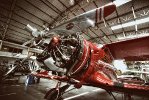Beechcraft Staggerwing
The Model 17’s unusual negative stagger wing configuration (the upper wing staggered behind the lower) and unique shape maximized pilot visibility while minimizing the tendency to stall. The fabric-covered fuselage was faired with wood formers and stringers over a welded, steel tube frame. Construction was complex and took many man-hours to complete. The Staggerwing’s retractable conventional landing gear, uncommon at that time, combined with streamlining, light weight, and powerful radial engines helped it perform significantly better than other biplane designs.
In the mid-1930s, Beech began a major redesign of the aircraft, to create the Model D17 Staggerwing. The D17 featured a lengthened fuselage that improved the aircraft’s landing characteristics by increasing the leverage generated by the elevator. They relocated the Ailerons to the upper wings, eliminating any interference with the air flow over the flaps. Braking was improved with a foot-operated brake synchronized to the rudder pedals. These modifications enhanced the Staggerwing’s performance, which was soon put to the test under wartime conditions.
Dehavilland Chipmunk
The Chipmunk was designed to succeed the de Havilland Tiger Moth biplane trainer that was widely used during the Second World War. Wsiewolod Jakimiuk, a Polish prewar engineer, created the first indigenous design of the aircraft at de Havilland Aircraft of Canada Ltd. It is an all-metal, low wing, tandem two-place, single engine aircraft with a conventional tail wheel landing gear and fabric-covered control surfaces. The wing is also fabric-covered aft of the spar. A clear perspex canopy covers the pilot/student (front) and instructor/passenger (rear) positions. CF-DIO-X, the Chipmunk prototype, flew for the first time at Downsview, Toronto on 22 May 1946 with Pat Fillingham, test pilot from the parent de Havilland company, at the controls[1]. The production version of the airplane was powered by a 145 hp (108 kW) in-line de Havilland Gipsy Major 8 engine while the prototype was powered by a 145 hp (108 kW) de Havilland Gipsy Major 1C.
The Model 17’s unusual negative stagger wing configuration (the upper wing staggered behind the lower) and unique shape maximized pilot visibility while minimizing the tendency to stall. The fabric-covered fuselage was faired with wood formers and stringers over a welded, steel tube frame. Construction was complex and took many man-hours to complete. The Staggerwing’s retractable conventional landing gear, uncommon at that time, combined with streamlining, light weight, and powerful radial engines helped it perform significantly better than other biplane designs.
In the mid-1930s, Beech began a major redesign of the aircraft, to create the Model D17 Staggerwing. The D17 featured a lengthened fuselage that improved the aircraft’s landing characteristics by increasing the leverage generated by the elevator. They relocated the Ailerons to the upper wings, eliminating any interference with the air flow over the flaps. Braking was improved with a foot-operated brake synchronized to the rudder pedals. These modifications enhanced the Staggerwing’s performance, which was soon put to the test under wartime conditions.





